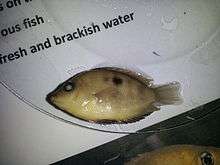Pseudetroplus maculatus
| Pseudetroplus maculatus | |
|---|---|
| | |
| Scientific classification | |
| Kingdom: | Animalia |
| Phylum: | Chordata |
| Class: | Actinopterygii |
| Order: | Perciformes |
| Family: | Cichlidae |
| Subfamily: | Etroplinae |
| Genus: | Pseudetroplus [1] Bleeker, 1862 |
| Species: | P. maculatus |
| Binomial name | |
| Pseudetroplus maculatus (Bloch, 1795) | |
| Synonyms | |
|
Etroplus maculatus Bloch, 1795 | |
Pseudetroplus maculatus, also known as the orange chromide, is a species of fish endemic to freshwater and brackish streams, lagoons and estuaries in southern India and Sri Lanka.[1][2] It is also known as pallathi (Malayalam: പള്ളത്തി) in Malayalam. The species is popular with fishkeeping hobbyists, and is kept frequently in aquariums.[2][3] The species is part of the family Cichlidae and is included in subfamily Etroplinae.
Diet

The species co-occurs throughout its range with Etroplus suratensis. Orange chromides prey on the eggs and larvae of E. suratensis and also act as a "cleaner fish" removing parasites from the larger green chromides in a cleaning symbiosis. Other fish that exhibit such cleaning behavior include cleaner wrasses and goby fish (Elacatinus spp.)[2] The species also feeds on zooplankton and algae.
Parental care
According to [4] (citing Ward and Ballow, 1967 and Wyman and Ward, 1973), young Entroplus maculatus feed on mucous coating of their parents; this is essential for the small fry survival. During the feeding period, the parent fish mucous glands increase 34%.
References
- 1 2 Pethiyagoda, R., Maduwage, K. & Manamendra-Arachchi, K. (2014): Validation of the South Asian cichlid genus Pseudetroplus Bleeker (Pisces: Cichlidae). Zootaxa, 3838 (5): 595–600.
- 1 2 3 Loiselle, P.V. (1995). The Cichlid Aquarium. Germany: Tetra Press. ISBN 1-56465-146-0.
- ↑ Riehl, R.. & Baensch, H.A. (1995). Aquarium Atlas. Germany: Tetra Press. ISBN 3-88244-050-3.
- ↑ Gerking, Shelby D. (Apr 25, 2014). Feeding Ecology of Fish. Elsevier. p. 286. ISBN 9781483288529.
